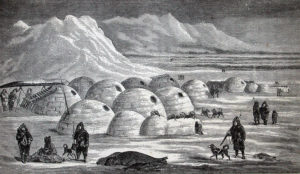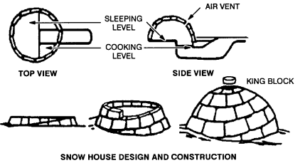Now that we have entered the snowy time in the year, we might as well embrace the snow. Although we may not see snow as a positive thing, there are many cultures that take advantage of its unique properties. The Inuit peoples of North America and Greenland use snow to create igloos, also spelled “iglu.” This form of shelter is also sometimes known as an aputiak. These temporary buildings are built entirely of snow, and are usually used as hunting lodges.

While a structure made out of snow may seem like a chilly prospect, but they Inuit hunters could stay in their igloos for entire winters quite comfortably. Not only does the igloo block cold wind, the densely packed snow acts as an insulator to keep those inside warm. In fact, the longer an igloo is used, the more durable it becomes! As people move around inside the structure, the snow melts but refreezes as temperatures drop, creating thin layers of ice. In fact, a well built igloo can support the weight of an entire person.
But how are igloos built? The main component needed is packed snow. Most snow that falls from the sky in Iowa isn’t going to be dense enough. If you want the appropriate building material you’ll either have to move north – at least to Northern Minnesota. If you find a snow bank that has been packed by wind, you may be able to cut it out and use it, but you will likely need to put in some extra work to pack snow to make blocks.
Once you choose how large you would like your structure to be, you can begin building. These blocks should not be completely square, but wedge-shaped. This, combined with building in a spiral allows for a self-supported dome. If your dome is completely semi-circular, not all of the blocks share compressive forces, making it more likely to fall. Instead, build your igloo to be a parabolic or catenary arch, more egg-shaped than the dome on the Old Capitol. If you want all the ins and outs of the project, come in and check out How to Build an Igloo and Other Snow Shelters by Norbert E. Yankielun.
If you don’t think you can make your own igloo from scratch, you don’t have to be completely kept out of the fun. A Canadian company called PlaySnow makes igloo-shaped support structures that can be covered in snow to make a structure that is sturdy and safe from collapse. They are designed for children, so take that into consideration before you purchase one for your wintertime fun, since a too-small igloo is uncomfortable.

Works Cited
Editors of Encyclopaedia Britannica. (n.d.). igloo | dwelling. Encyclopedia Britannica. https://www.britannica.com/technology/igloo
Hoyt, A. (2021, February 20). How Igloos Work. HowStuffWorks. https://people.howstuffworks.com/igloo.htm
New World Encyclopedia. (n.d.). Igloo. https://www.newworldencyclopedia.org/entry/Igloo
Santa’s Lapland. (n.d.). Interesting Facts About Igloos | Santa’s Lapland. https://www.santaslapland.com/more-magic/7-interesting-facts-about-igloos/
Yankielun, N. E., & Bauer, A. (2007). How to Build an Igloo: And Other Snow Shelters (Illustrated ed.). W. W. Norton & Company.
